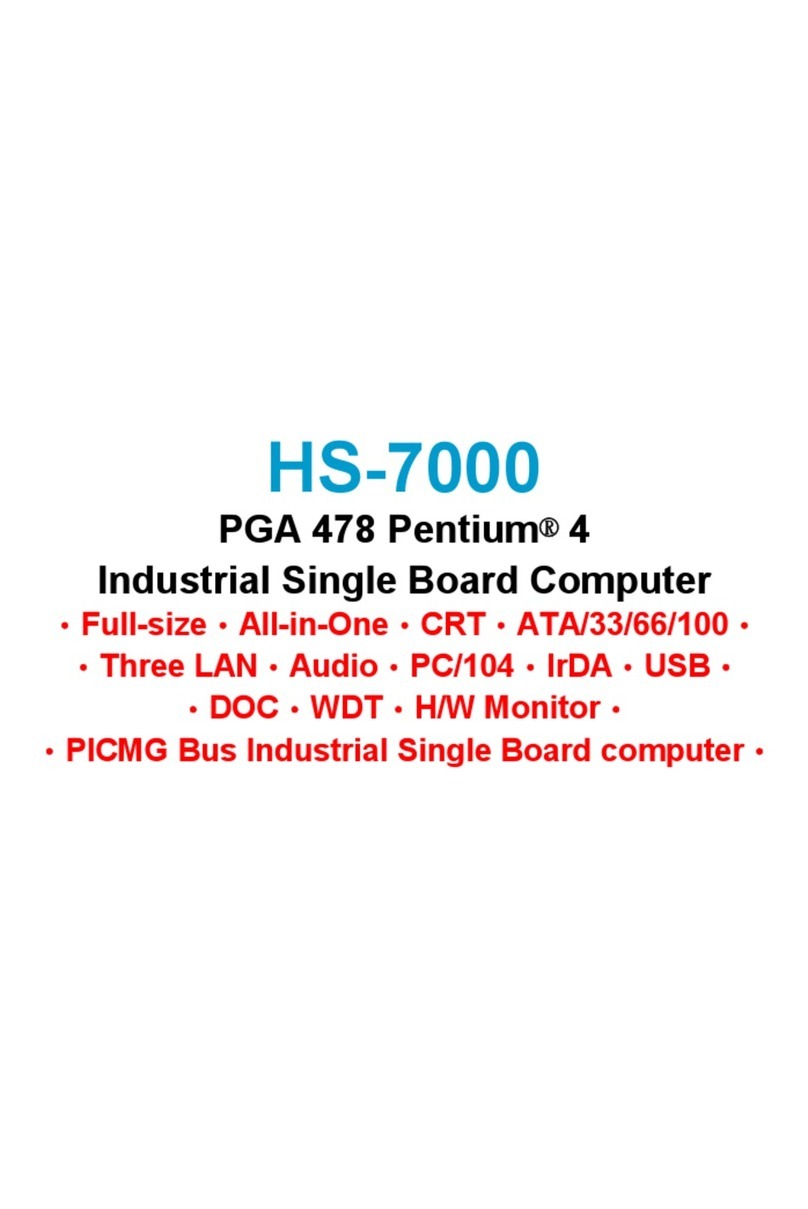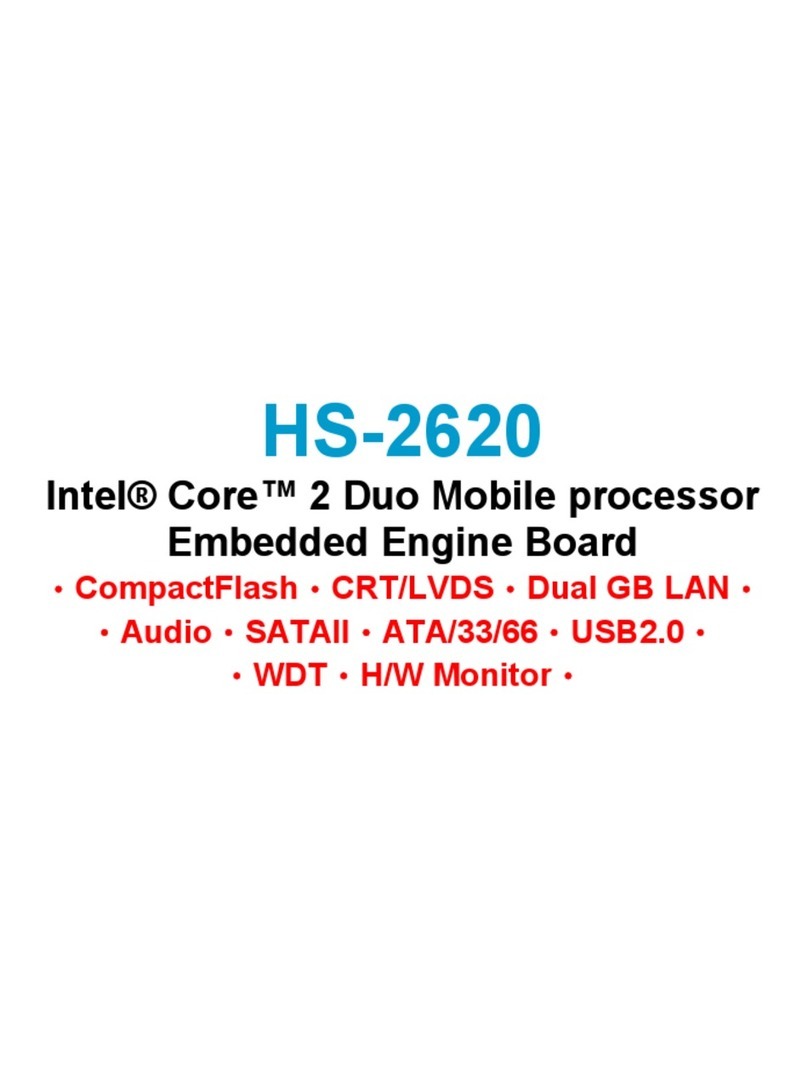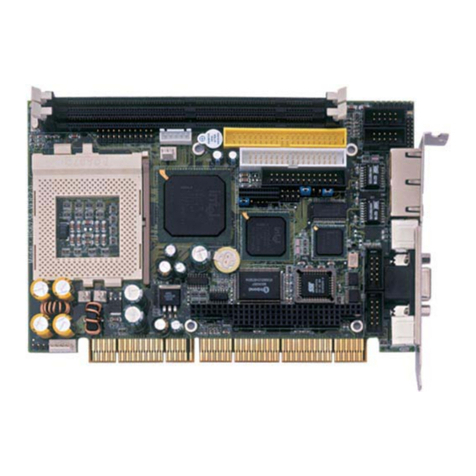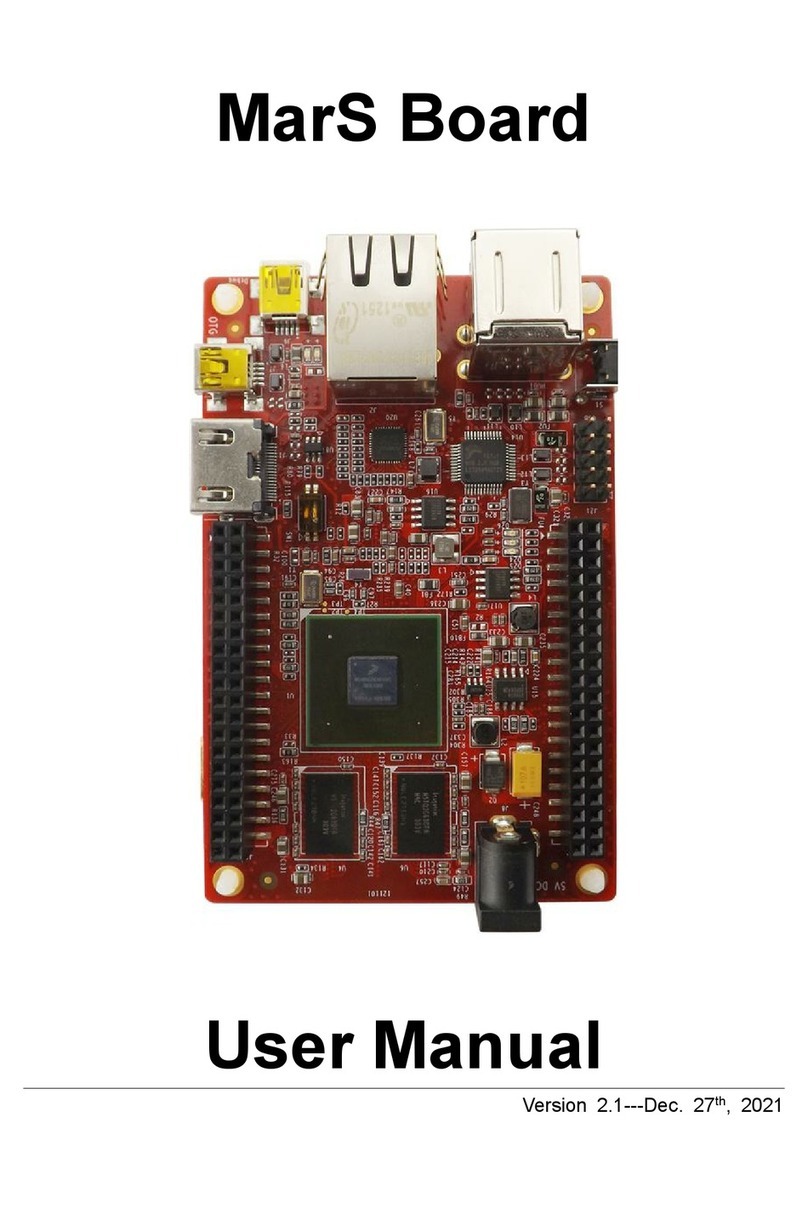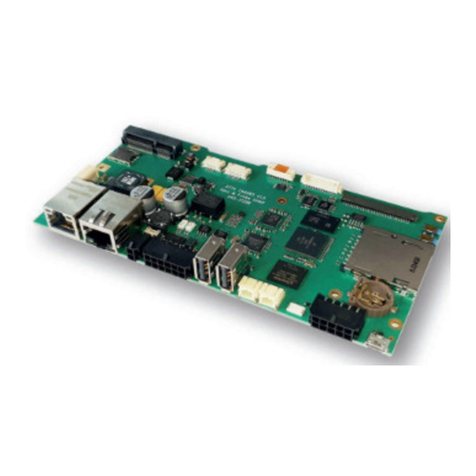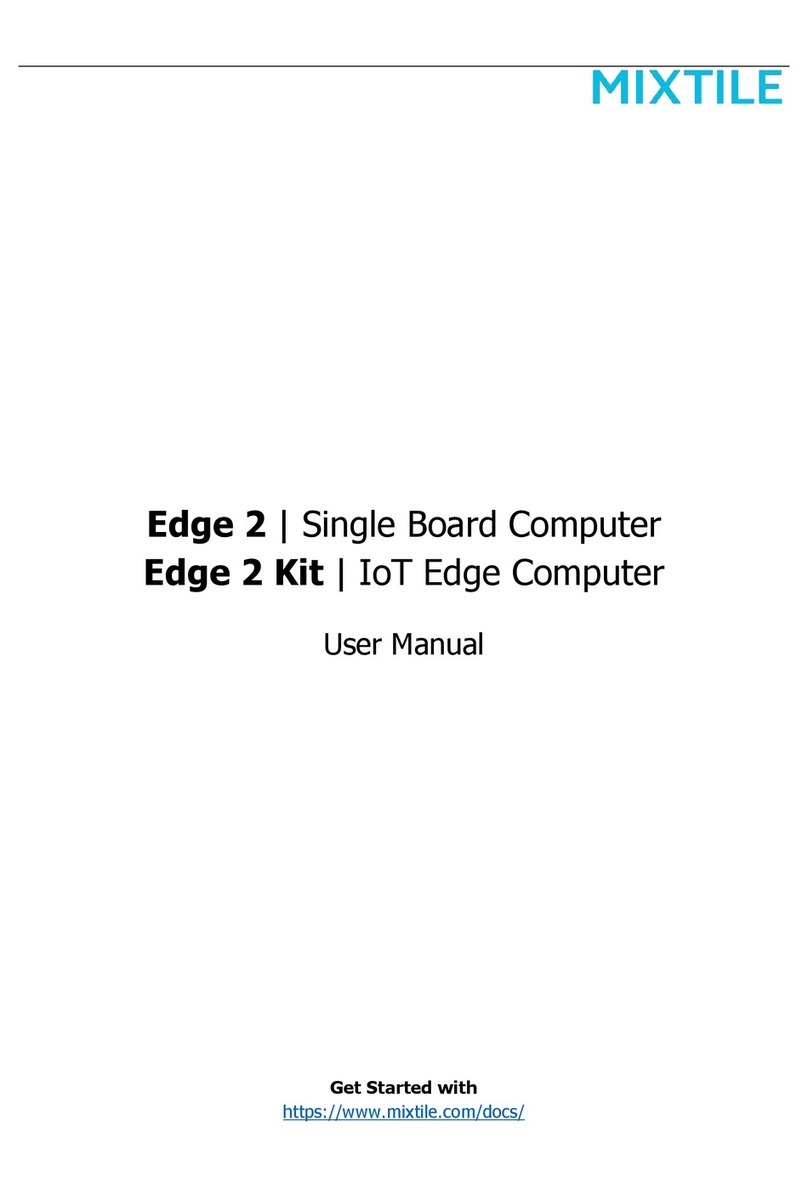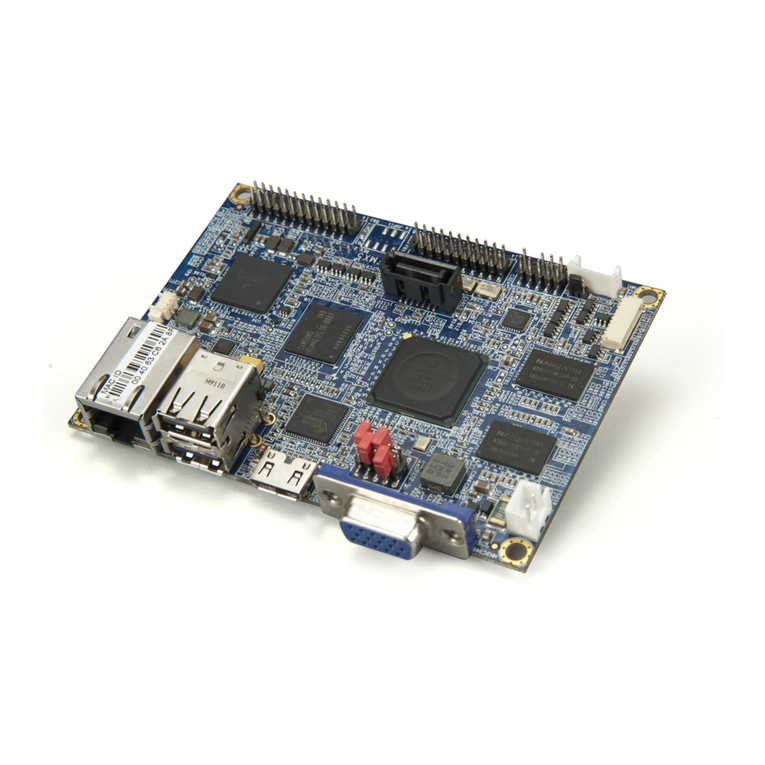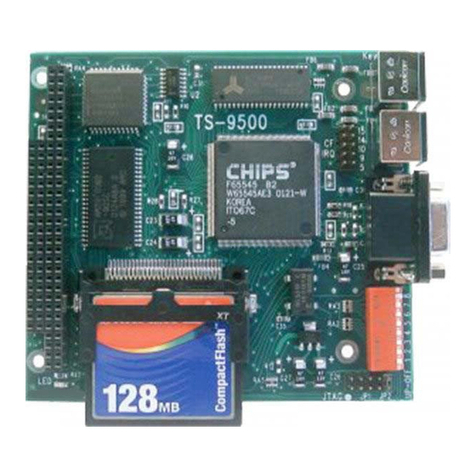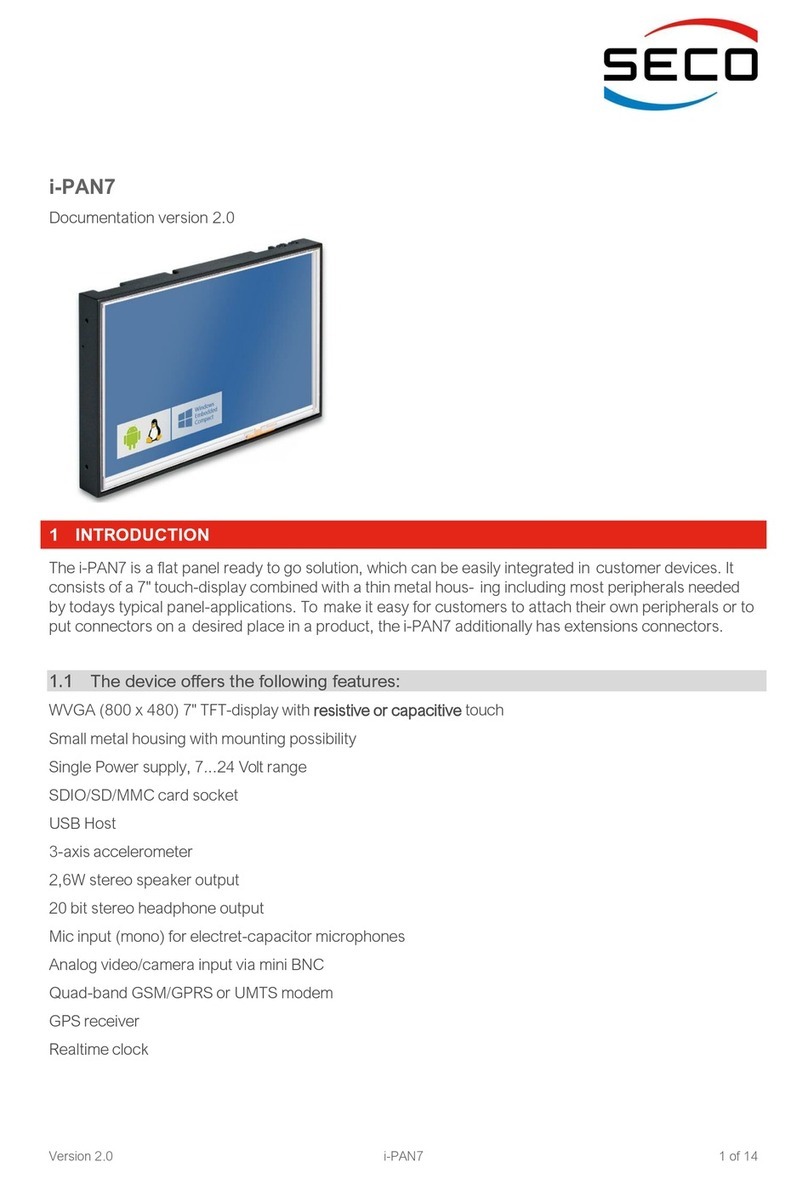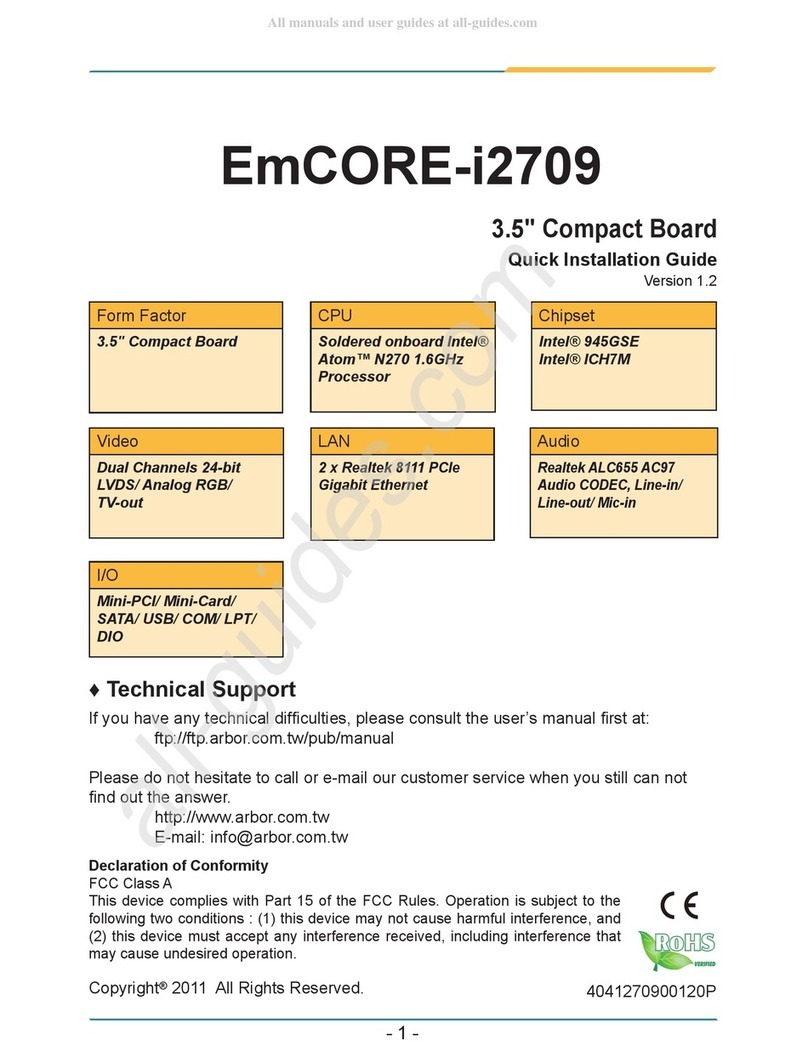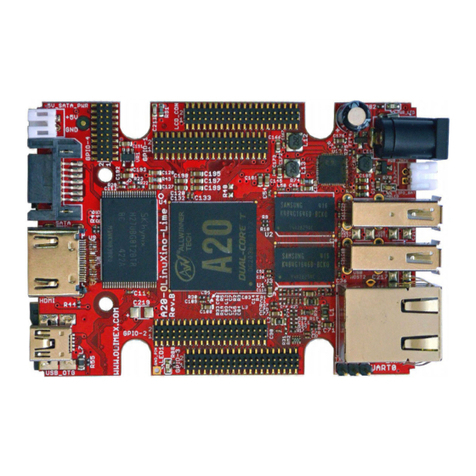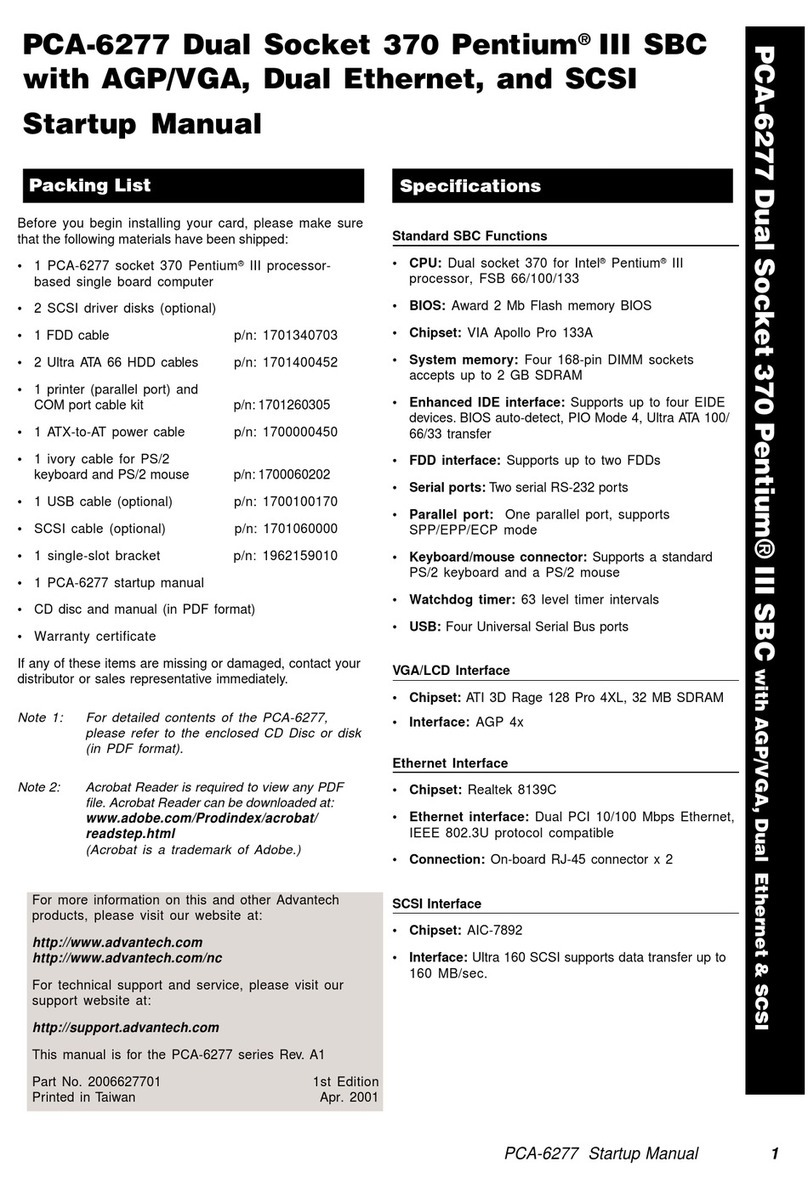BOSER Technology HS-5011 User manual

HS-5011
Pentium®MMXTM PICMG Bus SBC
•Full Size•CRT/Panel•ATA/33/66•LAN•
•Audio•RS-232/422/485•PC/104•IrDA•USB•
•DOC•WDT•CTA•
•PICMG Bus Industrial Single Board Computer•

C
C
Co
o
op
p
py
y
yr
r
ri
i
ig
g
gh
h
ht
t
t
D
D
Di
i
is
s
sc
c
cl
l
la
a
ai
i
im
m
me
e
er
r
rs
s
s
The accuracy of contents in this manual has passed thorough checking and review
before publishing. BOSER Technology Co., Ltd., the manufacturer and publisher, is
not liable for any infringements of patents or other rights resulting from its use. The
manufacturer will not be responsible for any direct, indirect, special, incidental
or consequential damages arising from the use of this product or
documentation, even if advised of the possibility of such damage(s).
This manual is copyrighted and BOSER Technology Co., Ltd. reserves all
documentation rights. Unauthorized reproduction, transmission, translation,
and storage of any form and means (i.e., electronic, mechanical, photocopying,
recording) of this document, in whole or partly, is prohibited, unless granted
permission by BOSER Technology Co., Ltd.
BOSER Technology Co., Ltd. reserves the right to change or improve the
contents of this document without due notice. BOSER Technology Co., Ltd.
assumes no responsibility for any errors or omissions that may appear in this
manual, nor does it make any commitment to update the information contained
herein.
T
T
Tr
r
ra
a
ad
d
de
e
em
m
ma
a
ar
r
rk
k
ks
s
s
BOSER is a registered trademark of BOSER Technology Co., Ltd.
ISB is a registered trademark of BOSER Technology Co., Ltd.
Intel is a registered trademark of Intel Corporation.
Award is a registered trademark of Award Software, Inc.
All other trademarks, products and or product names mentioned herein are
mentioned for identification purposes only, and may be trademarks and/or
registered trademarks of their respective companies or owners.
© Copyright 2003 BOSER Technology Co., Ltd.
All Rights Reserved.
Edition 1.3 March 06, 2003

Table of Contents
Chapter 1 General Description..............................1
1.1 Major Features.................................................................. 2
1.2 Specifications ................................................................... 3
1.3 Board Dimensions............................................................ 4
Chapter 2 Unpacking .............................................5
2.1 Opening the Delivery Package........................................ 5
2.2 Inspection.......................................................................... 5
Chapter 3 Hardware Installation ..........................7
3.1 Before Installation ............................................................ 7
3.2 HS-5011 Board Layout ..................................................... 8
3.3 HS-5011 Jumper List........................................................ 9
3.4 HS-5011 Connector List................................................. 10
3.5 System Memory.............................................................. 11
3.6 DiskOnChipAddress Setting ..................................... 11
3.7 Setting the CPU of HS-5011........................................... 11
3.8 Watchdog Timer ............................................................. 13
3.9 CMOS Data Clear............................................................ 15
3.10 VGA Controller................................................................ 15
3.11 Serial Port Connectors .................................................. 18
3.12 Keyboard & Mouse Connector...................................... 19
3.13 Front Panel Connector................................................... 20
3.14 PCI E-IDE Drive Connector............................................ 21
3.15 Parallel Connector.......................................................... 22
3.16 Floppy Disk Drive Connector ........................................ 23
3.17 Audio Connectors .......................................................... 23
3.18 CPU Temperature Alarm Setting................................... 24
3.19 Fast Ethernet Connector ............................................... 25
3.20 IrDA Connector............................................................... 25
3.21 PC/104 Bus Connection................................................. 26
3.22 USB Connector............................................................... 27
3.23 Power and FAN Connectors.......................................... 28

Chapter 4 Award BIOS Setup .............................29
4.1 Starting Setup ................................................................. 29
4.2 Using Setup..................................................................... 30
4.3 Main Menu ....................................................................... 31
4.4 Standard CMOS Setup ................................................... 33
4.5 BIOS Features Setup...................................................... 35
4.6 Chipset Features Setup ................................................. 40
4.7 Power Management Setup............................................. 41
4.8 Integrated Peripherals ................................................... 42
4.9 PNP/PCI Configuration Setup ....................................... 44
4.10 Load BIOS Defaults........................................................ 45
4.11 Load Setup Defaults....................................................... 46
4.12 Supervisor/User Password Setting .............................. 47
4.13 IDE HDD Auto Detection ................................................ 48
4.14 Save & Exit Setup........................................................... 49
4.15 Exit Without Saving........................................................ 50
Chapter 5 Software Utilities.................................51
5.1 VGA Driver Installation for Win 95/98........................... 51
5.2 VGA Driver Installation for Win NT4.0.......................... 53
5.3 Audio Driver Installation for Win 98/95 ........................ 55
5.4 Audio Driver Installation for Win NT4.0 ....................... 57
5.5 Network Driver Installation for Win95/98 ..................... 59
5.6 Network Driver Installation for Win NT4.0 ................... 61

S
S
Sa
a
af
f
fe
e
et
t
ty
y
y
I
I
In
n
ns
s
st
t
tr
r
ru
u
uc
c
ct
t
ti
i
io
o
on
n
ns
s
s
Integrated circuits on computer boards are sensitive to static electricity.
To avoid damaging chips from electrostatic discharge, observe the
following precautions:
Do not remove boards or integrated circuits from their anti-static
packaging until you are ready to install them.
Before handling a board or integrated circuit, touch an unpainted portion
of the system unit chassis for a few seconds. This helps to discharge any
static electricity on your body.
Wear a wrist-grounding strap, available from most electronic component
stores, when handling boards and components. Fasten the ALLIGATOR
clip of the strap to the end of the shielded wire lead from a grounded
object. Please wear and connect the strap before handle the HS-5011 to
ensure harmlessly discharge any static electricity through the strap.
Please use an anti-static pad when putting down any components or
parts or tools outside the computer. You may also use an anti-static bag
instead of the pad. Please inquire from your local supplier for additional
assistance in finding the necessary anti-static gadgets.
NOTE: DO NOT TOUCH THE BOARD OR ANY OTHER SENSITIVE
COMPONENTS WITHOUT ALL NECESSARY ANTI-STATIC
PROTECTION.

This page is intentionally left blank.

1
Chapter 1
General Description
The HS-5011 is Full size PICMG Bus Pentium®MMX™ Industrial
Single Board Computer. The board design combine together with all
necessary input and output effects interfaces which makes it an ideal
all-in-one industrial single board computer. The board design with
100MHz FSB clock rate architecture.
The HS-5011 provides one set of PC/104 bus connector for 16-bit ISA
bus. The board also designs with an ESS®Solo1 3D audio provides an
ideas audio adapter in any audio application.
The IDE interface with ATA/33/66 access of mode 4 to IDE drive
interface architecture, supports with maximum 66MB/sec in data
transfer rating to four IDE drive connection and provides an onboard
Intel®82559 10/100 based LAN for easy network connection.
The board design with C&T 69000 CRT/Panel display controller
provides internal connection to CRT and Panel display. It can supports
up to 1280 x 1024 at 256 colors.
A single Flash chip holds the system BIOS, and you can change the
Flash BIOS by the Utility Update. Advanced IR also provides a faster
data transmission. You can also use the DOS version of the
"DiskOnChip" socket by issuing commands from the DOS prompt
without the necessity of other software supports up to 288MB.

2
The HS-5011 supports memory at three DIMM sockets. This gives you
the flexibility of configuring your system from 8MB to 1.5GB by using
the most economical DIMM memory modules for its onboard system
SDRAM.
If a non-expect program cause halts, the onboard Watchdog Timer
(WDT) will automatically reset the CPU or generate an interrupt. The
WDT is designed with pure hardware and doesn’t need any arithmetical
functions of a real-time clock chip. This ensures the reliability in an
unmanned or standalone system.
1.1 Major Features
The HS-5011 comes with the following features:
75~500MHz CPU for Intel®Pentium®MMXTM/Tillamook/K5/K6
Ali M1541/M1543 system chipset
Fast PCI ATA/33/66 IDE controller
Three DIMM sockets with a maximum capacity of 1.5GB
ALi M1543 super I/O chipset
One RS-232 and one RS-232/422/485 serial ports
PC/104 Bus connector
C&T 69000 CRT/Panel display controller
Intel 82559 10/100 Based LAN
ESS®Solo1 3D audio controller
DiskOnChipTM socket supporting memory sizes of up to 288MB
Two USB connectors
Supports ATX power function
Supports CPU Temperature Alarm function
Switching power regulator

3
1.2 Specifications
CPU: 75~500MHz CPU for Intel®Pentium®MMXTM /Tillamook/K5/K6
Bus Interface: PICMG Bus
Memory: Three DIMM sockets supporting up to 1.5GB
Chipset: ALi M1541/M1543
I/O Chipset: ALi M1543
VGA: C&T69000 with 2MB memory supporting CRT/Panel displays up
to 1280 x 1024 at 256 colors
IDE: Four IDE disk drives supporting ATA/33/66 and with a transfer rate
of up to 33/66MB/sec.
Floppy: Supports up to two floppy disk drives
Parallel Port: One enhanced bi-directional parallel port supporting
SPP/ECP/EPP
LAN: Intel®82559 10/100 Based LAN
Audio: ESS®Solo1 3D audio controller
Serial Port: 16C550 UART-compatible RS-232/422/485 x 1 and RS-232
x 1 serial ports with 16-byte FIFO
PC/104: PC/104 connector for 16-bit ISA Bus
IrDA: One IrDA TX/RX header
USB: Two USB connectors
Keyboard: PS/2 6-pin Mini DIN or 5-pin connector
Mouse: PS/2 6-pin Mini DIN or 4-pin connector
DiskOnChipTM: DiskOnChipTM socket supporting memory sizes of up to
288MB
BIOS: Award PnP Flash BIOS
Watchdog Timer: Sets 1, 2, 10, 20, 110, 220 seconds activity trigger
with Reset or NMI
CMOS: DS12C887 or equivalent device
DMA Channels: 7
Interrupt Levels: 15
Power: +5V, +12V, -12V
Maximum Power Consumption: +5V@6A, +12V@120mA,
-12V@50mA
Operating Temperature: 0~60°C
CPU Temperature Alarm: Beeping alarm when CPU temperature
exceeds temperature limits
Board Size: 33.8 x 12.1 cm

4
1.3 Board Dimensions

5
Chapter 2
Unpacking
This chapter explains unpacking the board, checking the equipment
and documentation and where to go from there.
2.1 Opening the Delivery Package
The HS-5011 is packed in an anti-static bag. The board has
components that are easily damaged by static electricity. Do not
remove the anti-static wrapping until proper precautions have been
taken. Safety Instructions in front of this manual describe anti-static
precautions and procedures.
2.2 Inspection
After unpacking the board, place it on a raised surface and carefully
inspect the board for any damage that might have occurred during
shipment. Ground the board and exercise extreme care to prevent
damage to the board from static electricity. Integrated circuits will
sometimes come out of their sockets during shipment. Examine all
integrated circuits, particularly the BIOS, processor, memory modules,
ROM-Disk, and keyboard controller chip to ensure that they are firmly
seated. The HS-5011 delivery package contains the following items:
HS-5011 Board
IDE port flat cable x 2
FDD port flat cable x 1
Printer port flat cable with bracket x 1
COM Port cable with bracket x 1
MIC/Audio 8-pin cable + 2 phone jacks with bracket x 1
5-pin ATX power cable x 1
Jumper bag x 1
Utility CD Disk
User’s Manual

6
It is recommended that you keep all the parts of the delivery package
intact and store them in a safe/dry place for any unforeseen event
requiring the return shipment of the product. In case you discover any
missing and/or damaged items from the list of items, please contact
your dealer immediately.

7
Chapter 3
Hardware Installation
This chapter provides the information on how to install the hardware
using the HS-5011. This chapter also contains information related to
jumper settings of switch, watchdog timer, and the DiskOnChipTM
address selection etc.
3.1 Before Installation
After confirming your package contents, you are now ready to install
your hardware. The following are important reminders and steps to take
before you begin with your installation process.
1. Make sure that all jumper settings match their default settings
and CMOS setup correctly. Refer to the sections on this chapter
for the default settings of each jumper.
2. Go through the connections of all external devices and make
sure that they are installed properly and configured correctly
within the CMOS setup. Refer to the sections on this chapter for
the detailed information on the connectors.
3. Keep the manual and diskette in good condition for future
reference and use.

8
3.2 HS-5011 Board Layout

9
3.3 HS-5011 Jumper List
Jumper Definition Setting Page
JP1(1-6) CPU Clock-in Multiplex Weighted
Value Select: x3 Short 3-4 11
JP1(7-16) CPU Vcore Voltage Select: 2.9V Short 7-8, 13-14 11
JP2 Host Bus Clock Rate Select: 100MHz Short 7-8 11
JP3 Audio Chipset “REQ” & “GNT” Select:
PCI1 Short 1-2 23
JP4 Panel Voltage Select: 3.3V Short 1-2 15
JP5 Audio Chipset “REQ” & “GNT” Select:
PCI1 Short 1-2 23
JP9 RS-422/485 Receiver Enabled/
Disabled Select: Always Disabled All Open 18
JP10 RS-422/485 Transceiver Enabled/
Disabled Select: Always Disabled Short 7-8 18
JP11 Clear CMOS: Normal Operation Open 15
JP12 RS-232 or RS-422/485 Select:
RS-232 Short 3-5, 4-6 18
JP13 RS-232 or RS-422/485 Select:
RS-232 Short 3-5, 4-6 18
JP14 Temperature Alarm Setting: Enabled Short 24
JP15(1-4) DiskOnChipTM Address Select: D000 Short 1-2 11
JP15(5-10) WDT Time Out Period Select: 1sec. Short 5-6, 7-8,
9-10 13
JP17 Watchdog Timer Active Type Select:
System Reset Short 2-3 13
JP22 LAN Enabled/Disabled by Hardware:
Tillamook Short 1-2 25
JP25 VGA Enabled/Disabled by Hardware:
Enabled Short 2-3 15
JP26 Tillamook CPU Enabled/Disabled
Select: Tillamook 266MHz Short 11

10
3.4 HS-5011 Connector List
Connector Definition Page
CN1 5-pin Keyboard Connector 19
CN2 Keylock Connector 20
CN3 Speaker Connector 20
CN4 2-pin ATX Power On/Off Connector 28
CN5 4-pin +5V/+12V Power Connector 28
CN6 Reset Connector 20
CN7 IDE LED Connector 20
CN8 & CN9 IDE1 & IDE2 Connector 21
CN10 20-pin ATX Power Connector 28
CN11 FDD Connector 23
CN12 64-pin PC/104 Bus Connector 26
CN13 USB Connector 27
CN14 40-pin PC/104 Bus Connector 26
CN15 Parallel Connector 22
CN16 COM1 Connector (5x2 header) 18
CN17 COM2 Connector (5x2 header) 18
CN18 RS-422/485 Connector (5x2 header) 18
CN19 CRT Connector (5x2 header) 15
CN20 RJ-45 Connector 25
CN21 15-pin CRT Connector 15
CN22 PS/2 6-pin Mini DIN Mouse Connector 19
CN23 PS/2 6-pin Mini DIN Keyboard Connector 19
CN24 COM2 Connector (DB9) 18
CN26 4-pin Mouse Connector 19
DM1 & DM2 & DM3 DIMM Socket 11
JP6 Panel Connector 15
JP7 5-pin ATX Power Connector 28
JP8 IrDA Connector 25
JP18 Aux Audio Input Connector 23
JP19 Line In Connector 23
JP20 MIC In/Audio Out Connector 23
JP21 LAN Connection LED 25
JP23 LAN Active LED 25
JP24 LAN Speed LED 25

11
3.5 System Memory
The HS-5011 provides three DIMM sockets at locations DM1, DM2 and
DM3. The maximum capacity of the onboard memory is 1.5GB.
3.6 DiskOnChipAddress Setting
The DiskOnChipTM function allows the system to boot or operate
without a FDD or a HDD. DiskOnChipTM modules may be formatted as
drive C or A. With DiskOnChipTM, user may also execute DOS
commands such as FORMAT, SYS, COPY, XCOPY, DISCOPY and
DISKCOMP etc.
The U18 location onboard the HS-5011 is the DiskOnChip module
socket. Jumper JP15(1-4) assigns the address setting of the installed
module. Setting the 4 pins of JP15(1-4) allows you to select the starting
memory address of the DiskOnChipTM (D.O.C.). If you have additional
memory devices in the system, please set both at different memory
address mapping to avoid the mapping area conflicts.
JP15(1-4): DiskOnChipAddress Select
PIN Address
Short 1-2 D000
Short 2-3 E000
3.7 Setting the CPU of HS-5011
The HS-5011 offers the convenience in CPU installation with its
auto-detect feature. After installing a new microprocessor onboard, the
HS-5011 automatically identifies the frequency and clock speed of the
installed microprocessor chip, thereby eliminating the need for user to
do additional CPU configuration or hardware settings related to it. The
HS-5011 provides all possibility in jumper setting for wide using all
types of CPU with JP1(7-16) for CPU Vcore Voltage, JP2 for Host Bus
Clock Rate and JP1(1-6) for CPU Clock-in Multiplex Weighted Value
setting as following. Please contact with your CPU’s supplier in getting
those information for correctly setting. Any wrong setting may cause
CPU defect.
Correspond to different type CPU, it is request to set JP1(7-16) for
match the CPU's Vcore operating voltage. Here shows at below of the
proper jumper settings for their respective Vcore at range 1.8V to 3.5V.

12
JP1(7-16): CPU Vcore Voltage Select
CPU Vcore Voltage JP1(7-16)
1.8V Short 9-10, 13-14, 15-16
1.9V Short 11-12, 13-14, 15-16
2.0V Short 9-10, 11-12, 13-14, 15-16
2.1V Short 7-8
2.2V Short 9-10
2.3V Short 7-8, 9-10
2.4V Short 11-12
2.5V Short 7-8, 11-12
2.6V Short 9-10, 11-12
2.7V Short 7-8, 9-10, 11-12
2.8V Short 13-14
2.9V Short 7-8, 13-14
3.0V Short 9-10, 13-14
3.1V Short 7-8, 9-10, 13-14
3.2V Short 11-12, 13-14
3.3V Short 7-8, 11-12, 13-14
3.4V Short 9-10, 11-12, 13-14
3.5V Short 7-8, 9-10, 11-12, 13-14
JP2 used to setting the Host Bus clock Rate. The setting of internal host
bus clock rate is for defined the defined the operating clock base rate of
the internal bus of core logic.
JP2: Host Bus Clock Rate Select
Host Bus Clock Rate JP2
60MHz Short 1-2, 3-4, 5-6, 7-8
66.8MHz Short 3-4, 5-6, 7-8
75MHz Short 1-2, 3-4, 7-8
100MHz Short 7-8
JP1(1-6) used to setting the CPU Clock-in Multiplex Weighted Value.
The setting value is for multiplex to internal host bus clock rate and
obtain the CPU operating clock value.

13
JP1(1-6): CPU Clock-in Multiplex Weighted Value Select
JP1(1-6)
1-2 3-4 5-6
CPU Clock In Multiplex
Weighted Value
Short Open Open X 2
Short Short Open X 2.5
Open Short Open X 3
Open Open Open X 3.5(1.5)
Short Open Short X 4
Short Short Short X 4.5
Open Short Short X 5
Open Open Short X 5.5
The HS-5011 provides jumper for setting Intel®Tillamook low power
CPU by JP26 and select JP1, JP2 to match Tillamook CPU
requirement.
JP26: Tillamook CPU Enabled/Disabled Select
Tillamook 266MHz(4x) Description
JP26 ON Dual Power
1-2 3-4 5-6
JP1 ON OFF ON 3.5x or 4x
11-12 13-14 15-16
JP1 ON ON ON 1.9V
JP2 3-4, 5-6, 7-8 66.6MHz
3.8 Watchdog Timer
There are three access cycles of watchdog timer as Enable, Refresh
and Disable. The Enable cycle should proceed by READ PORT 443H.
The Disable cycle should proceed by READ PORT 045H. A continue
Enable cycle after a first Enable cycle means Refresh.
Once if the Enable cycle activity, a Refresh cycle is request before the
time-out period for restart counting the WDT Timer’s period. Otherwise,
it will assume that the program operation is abnormal when the time
counting over the period preset of WDT Timer. A System Reset signal
to start again or a NMI cycle to the CPU comes if over.
The JP17 is using for select the active function of watchdog timer in
disable the watchdog timer, or presetting the watchdog timer activity at
the reset trigger, or presetting the watchdog timer activity at the NMI
trigger.

14
JP17: Watchdog Timer Active Type Setting
JP17 Description
Short 1-2 Active NMI
Short 2-3 System Reset
Open Disabled Watchdog Timer
JP15(5-10): Watchdog Timer Out Period Select
Period 5-6 7-8 9-10
1 sec Short Short Open
2 sec Open Short Open
10 sec Short Open Open
20 sec Open Open Open
110 sec Short Short Short
220 sec Open Short Short
The watchdog timer is disabled after the system power-on. The
watchdog timer can be enabled by a Enable cycle with reading the
control port(443H), a Refresh cycle with reading the control port(443H)
and a Disable cycle by reading the watchdog timer disable control
port(045H). After a Enable cycle of WDT, user must constantly proceed
a Refresh cycle to WDT before its period setting comes ending of every
1, 2, 10, 20, 110 or 220 seconds (Please reference to the selection
table of JP8 for WDT Time Out period setting). If the Refresh cycle does
not active before WDT period cycle, the onboard WDT architecture will
issue a Reset or NMI cycle to the system. The watchdog timer is
controlled by two IO port.
443H I/O Read The Enable cycle
443H I/O Read The Refresh cycle
043H I/O Read The Disable cycle
The following sample program shows how to Enable, Disable and
Refresh the watchdog timer:
WDT_EN_RF EQU 0433H
WDT_DIS EQU 0043H
WT_Enable PUSH AX ; keep AX DX
PUSH DX
MOV DX,WDT_EN_RF ; enable the WDT
IN AL,DX
POP DX ; get back AX, DX
POP AX
RET
Table of contents
Other BOSER Technology Single Board Computer manuals
Popular Single Board Computer manuals by other brands
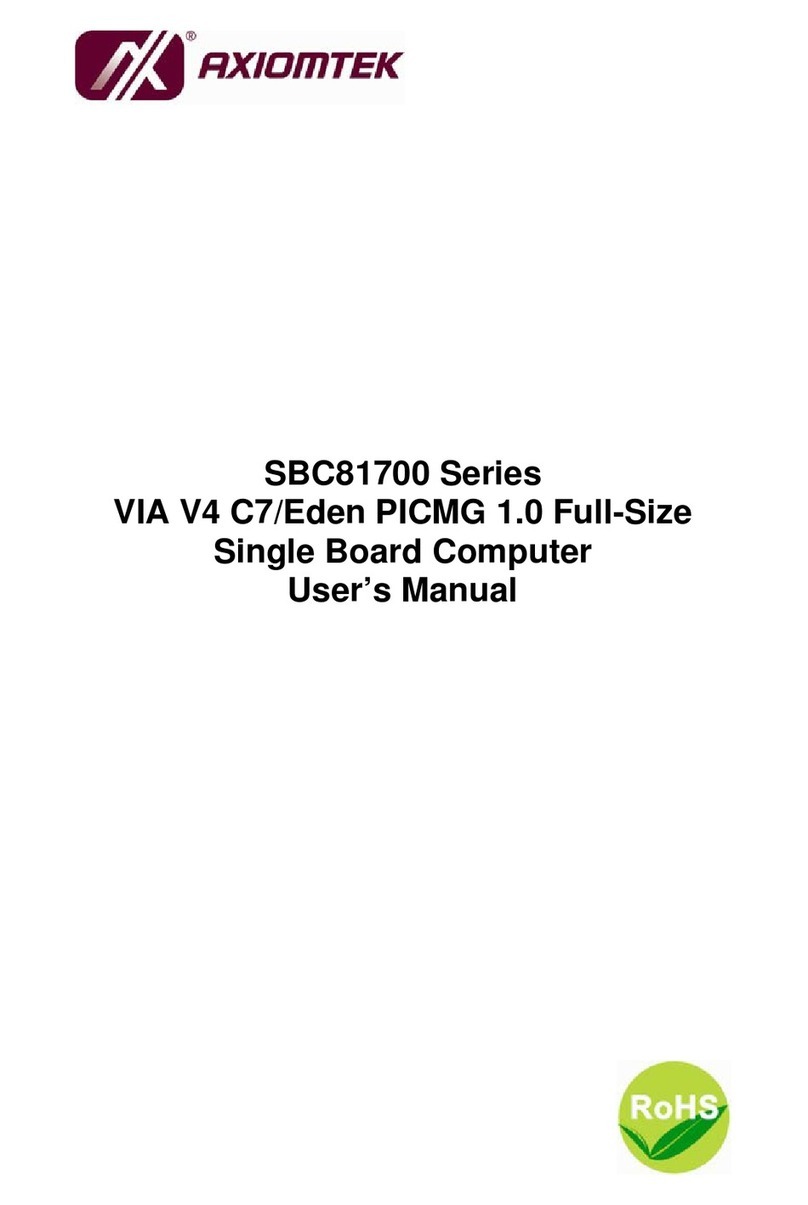
AXIOMTEK
AXIOMTEK SBC81700 Series user manual

Concurrent Technologies
Concurrent Technologies PP 110/01 Series Technical reference manual
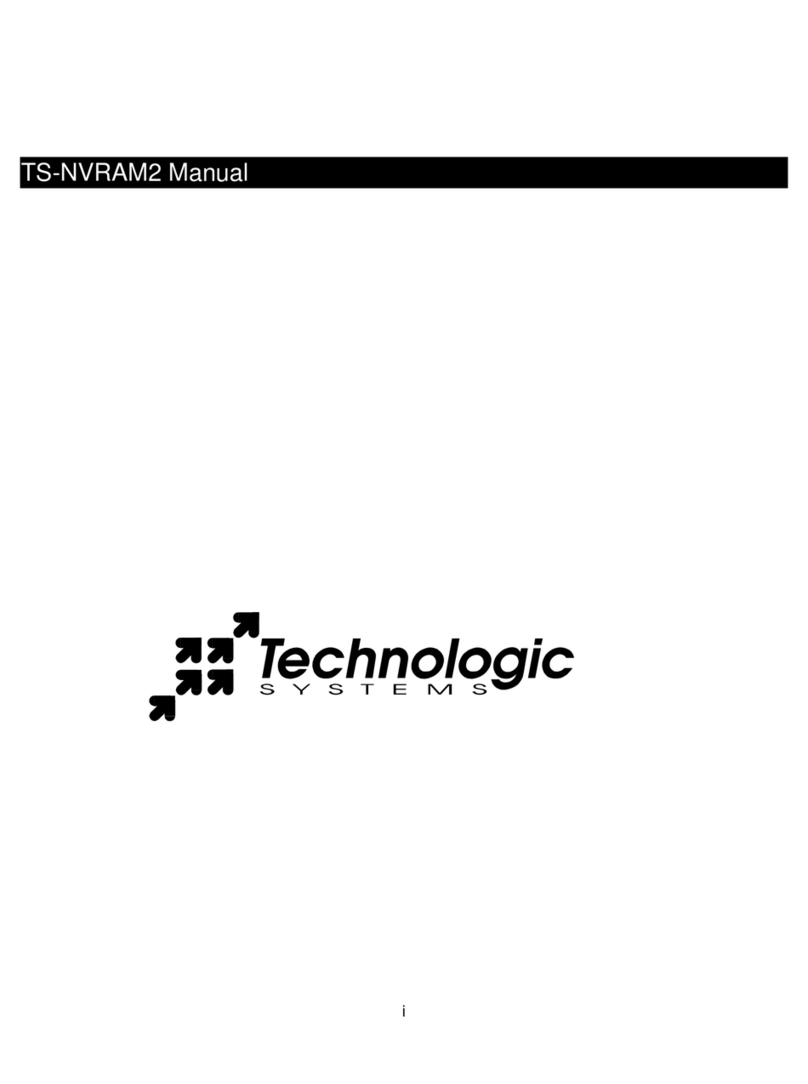
Technologic Systems
Technologic Systems TS-NVRAM2 manual
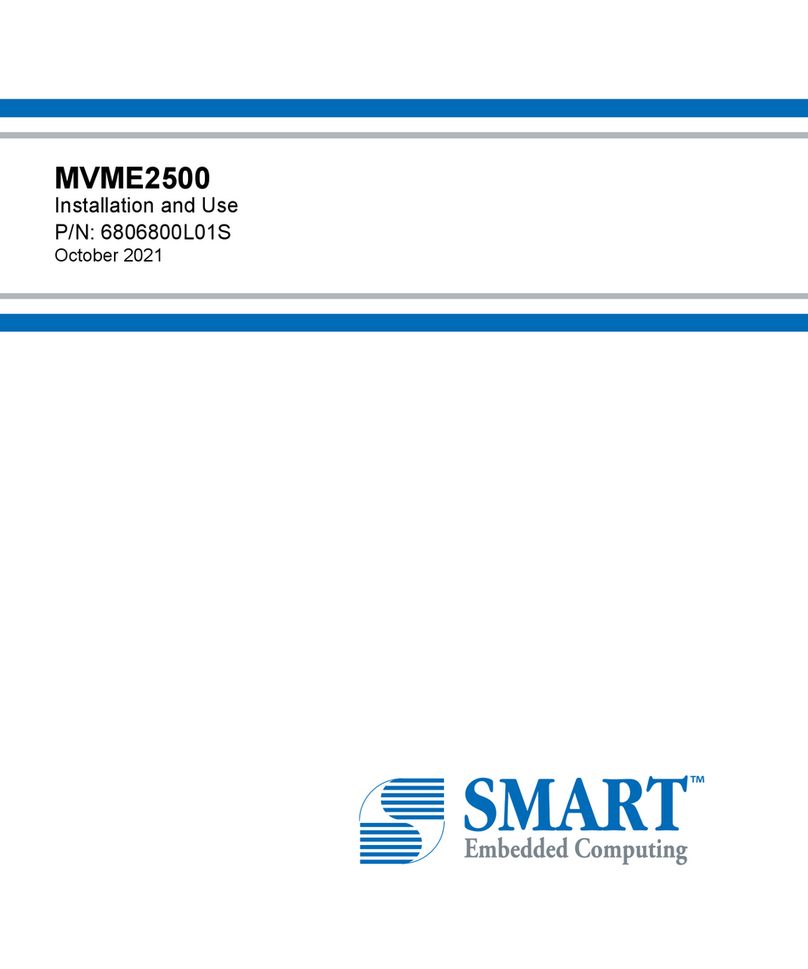
SMART Embedded Computing
SMART Embedded Computing MVME2500 Installation & use
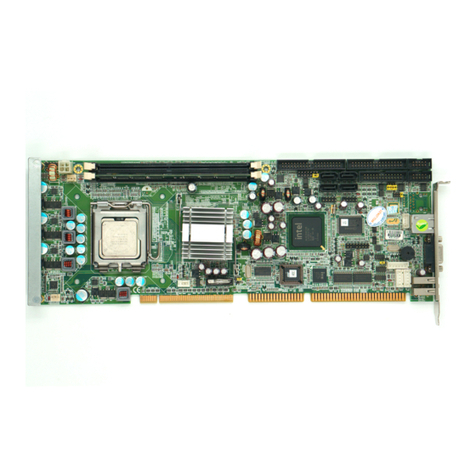
AXIOMTEK
AXIOMTEK SBC81206 Series Quick installation guide

PCW Microsystems
PCW Microsystems SBC1134 user manual

